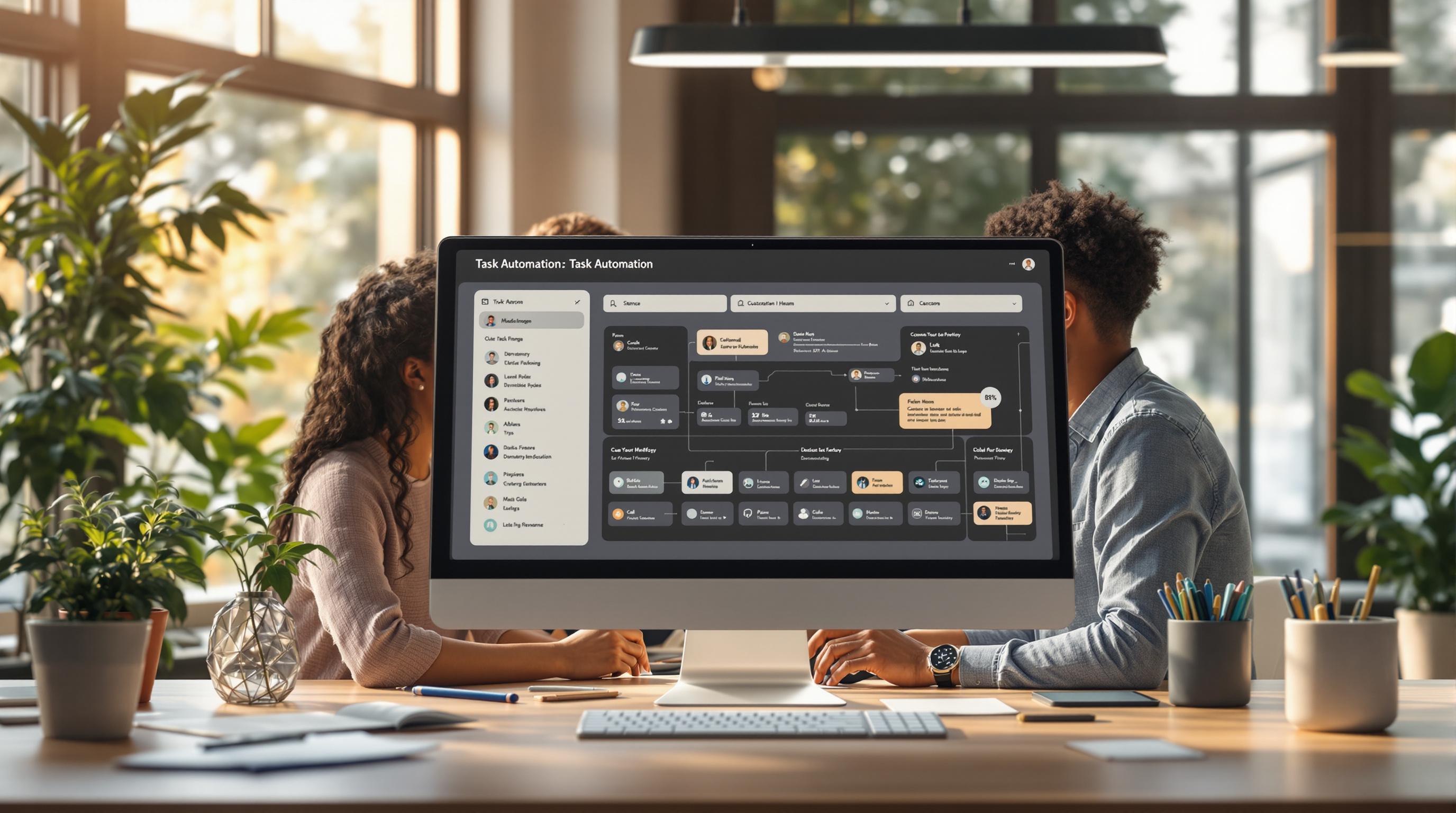AI is transforming how businesses define job roles and identify skill gaps. By analyzing job descriptions, performance data, and evolving market needs, AI skill frameworks create precise role definitions that align workforce skills with business goals. Here's what you need to know:
- What It Does: AI frameworks analyze data to define roles, identify skill gaps, and refine hiring processes.
- Key Benefits:
- Accurate role definitions reduce hiring mismatches.
- Automated processes save time and resources.
- Data-driven insights guide workforce training and planning.
- How to Get Started:
- Assess current job descriptions and skill requirements.
- Gain internal support from leadership and teams.
- Choose AI tools that integrate with your HR systems.
- Configure AI systems with detailed role data and validation rules.
Related video from YouTube
Getting Started with AI Role Definition
Implementing AI-based role definitions takes careful planning. Here's how to get started.
Review Current Roles
Start by assessing your existing job descriptions and skill requirements. This step lays the groundwork for AI integration:
- Create a detailed inventory of roles, skills, responsibilities, and performance metrics.
- Identify roles that are outdated or no longer align with organizational needs.
- Collect historical data on top-performing employees in each role to help train the AI system.
A structured review ensures the AI has accurate and relevant data to work with.
Build Internal Support
Gaining internal support is crucial for successful implementation. Here’s how to get everyone on board:
- Executive Sponsorship: Get leadership buy-in by showcasing the benefits, such as improved efficiency and better talent management. Highlight potential ROI to make your case compelling.
- Stakeholder Engagement: Form a cross-functional team that includes HR, department leaders, and employees who will interact with the system.
-
Communication Strategy: Create a clear plan to address common concerns about AI adoption. Use the table below to guide your messaging:
Concern How to Address It Job Security Explain that AI supports decision-making rather than replacing human input. Data Privacy Share details about security measures and compliance with privacy regulations. Implementation Timeline Provide a clear schedule with milestones and training opportunities.
Once you’ve secured internal buy-in, move on to selecting the right AI tool.
Select AI Software
Choosing the right AI software is a critical step. Focus on these key factors:
Technical Requirements:
- Ensure the tool integrates seamlessly with your current HR systems.
- Look for customization options tailored to your industry.
- Prioritize tools with strong data security and compliance features.
Operational Needs:
- Opt for software that’s user-friendly for HR teams.
- Assess the training and support provided by the vendor.
- Consider deployment flexibility to ensure the system meets your specific needs.
For help finding the right tool, resources like AI for Businesses can guide you to solutions that simplify HR tasks and role definition processes.
Setting Up AI Role Definition Tools
Once you've selected your AI software, it's time to configure it for defining roles accurately.
Data Entry and Setup
Start with well-organized and detailed data to ensure your AI performs effectively. Focus on these areas:
Role Data Structure:
- Job titles and descriptions
- Required skills and competencies
- Performance metrics
- Reporting relationships
- Certification requirements
Use a consistent template to capture all critical details:
| Data Category | Required Fields | Format Example |
|---|---|---|
| Basic Role Info | Title, Department, Level | Software Engineer, Engineering, L3 |
| Skills | Technical, Soft, Domain | Python (Required), Communication (Essential) |
| Experience | Years, Type, Industry | 3-5 years, Full-stack development |
| Metrics | KPIs, Success Criteria | Code quality score >90%, Sprint completion rate |
Once your data is organized, customize the system to fit your company's specific requirements.
AI System Configuration
Fine-tune the AI system to align with your organization's structure and expectations:
Key Settings to Adjust:
- Industry-specific language
- Company role hierarchies
- Custom skill classifications
- Regulatory compliance needs
- Automated validation settings
Define validation rules to ensure role definitions meet your internal standards. Focus on these configuration areas:
- Skill Mapping: Link relevant skills to corresponding roles.
- Role Levels: Set clear criteria for career progression.
- Compliance Rules: Specify certifications or credentials required for certain roles.
Reading AI Role Reports
Interpreting AI-generated role reports involves understanding specific metrics and insights:
Important Report Elements:
- Skills gap analysis
- Role alignment scores
- Competency matching
- Career growth pathways
- Training suggestions
Pay attention to the following metrics:
| Metric | Purpose | Action Threshold |
|---|---|---|
| Skills Match | Assesses how well talent aligns with role needs | Below 80% requires review |
| Role Clarity | Measures how clearly role requirements are defined | Minimum 85% clarity score |
| Compliance Score | Verifies adherence to regulatory standards | 100% compliance required |
When reviewing reports, focus on any unexpected results or outliers. These could highlight areas where the AI's role understanding needs adjustment or where your organization's unique requirements aren't fully addressed.
sbb-itb-bec6a7e
Testing and Improving AI Role Definitions
Once your setup and configuration are complete, the next step is testing. Regular testing and fine-tuning of AI-generated role definitions ensure they remain aligned with your business's evolving needs.
Review AI Outputs
Collaborate with department managers to evaluate the AI-generated role definitions. Check if:
- The technical and interpersonal skills align with the role's requirements.
- Job levels accurately reflect the responsibilities involved.
- Industry-specific language and compliance standards are followed.
- Career progression paths are clearly outlined.
Establish a feedback loop by sharing these role definitions with relevant teams. Use their input to refine the AI's outputs and make updates as necessary. This back-and-forth process ensures the definitions stay relevant and effective.
Refine Role Definitions
Use feedback and organizational changes to keep role definitions up to date. This includes:
- Tracking internal changes like new technologies, regulatory shifts, market demands, or company restructuring.
- Reviewing input from managers and analyzing performance data to pinpoint areas for improvement.
- Documenting updates, testing them in smaller groups, and rolling them out in stages.
Maintaining a record of all updates ensures consistency and helps in making informed, data-backed decisions for future refinements. These updates lay the groundwork for smoother integration into your HR processes.
Using AI Roles in HR Systems
Refined role definitions can serve as a foundation for optimizing various HR tasks. Here's how you can apply them effectively.
Job Listings and Hiring
Incorporate AI-driven role requirements into your job postings to clearly highlight essential skills and expectations.
Key elements to include:
- Clearly specify measurable skills and required proficiency levels.
- Outline career progression paths based on AI insights.
- Use precise language for requirements, such as "ability to explain technical concepts to non-technical audiences" instead of vague terms like "strong communication skills."
Once these roles are clearly defined, use them as a basis for performance evaluations.
Employee Reviews
Performance reviews should align with the competencies defined by AI. This ensures standardized evaluations and targeted feedback.
Templates for reviews can help by:
- Tracking skill growth against benchmarks for the role.
- Identifying areas for improvement to guide development plans.
This alignment between hiring criteria and performance reviews strengthens the connection between recruitment and ongoing performance management.
Skills Training Plans
Regularly updated role definitions provide valuable insights for crafting personalized training plans.
Steps to create effective training:
- Use AI to assess current skills against role requirements.
- Prioritize skills that have the biggest impact on performance.
- Develop learning paths tailored to individual progress and goals.
Here's a structured framework for AI-driven training:
| Component | Purpose | Implementation |
|---|---|---|
| Skill Assessment | Establish baseline competencies | Conduct regular evaluations using AI metrics |
| Gap Analysis | Pinpoint areas for development | Compare current skills to role-specific needs |
| Learning Path | Build a clear development plan | Organize training based on skill dependencies |
| Progress Tracking | Monitor improvement over time | Schedule check-ins and reassess skills regularly |
Conclusion: Next Steps with AI Role Definition
Defining roles using AI requires a clear, step-by-step approach to ensure smooth integration within your organization. Here's a framework to guide the process:
| Phase | Key Actions |
|---|---|
| Initial Assessment | Review skill matrices and ensure role alignment |
| Stakeholder Alignment | Set clear goals and gain support from key players |
| Tool Selection | Identify AI tools that fit your organization's goals |
| Implementation | Launch systems and train teams to use them effectively |
To make the process easier, consider using tools tailored for these tasks. For instance, platforms like AI for Businesses provide solutions such as Rezi for parsing resumes and Writesonic for crafting job descriptions, helping you get started quickly and efficiently.
Key Factors for Success:
- Open Communication: Keep HR teams and department leaders in sync.
- Validation: Regularly compare AI-generated roles with actual needs.
- Feedback Loops: Gather input to refine and improve skill frameworks.
- Strategic Alignment: Ensure AI-defined roles match your organization's goals.


